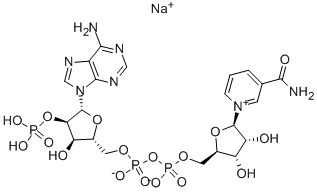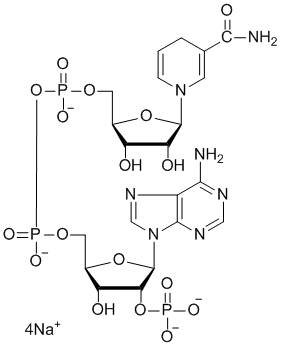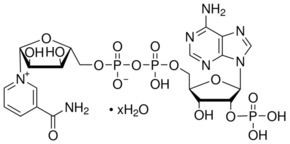Formula C21H29N7O17P3 | Molar mass 744.413 g/mol | |
 | ||
Nicotinamide adenine dinucleotide phosphate meaning
Nicotinamide adenine dinucleotide phosphate, abbreviated NADP+ or, in older notation, TPN (triphosphopyridine nucleotide), is a cofactor used in anabolic reactions, such as lipid and nucleic acid synthesis, which require NADPH as a reducing agent.
Contents

NADPH is the reduced form of NADP+. NADP+ differs from NAD+ in the presence of an additional phosphate group on the 2' position of the ribose ring that carries the adenine moiety.

In plants

In photosynthetic organisms, NADPH is produced by ferredoxin-NADP+ reductase in the last step of the electron chain of the light reactions of photosynthesis. It is used as reducing power for the biosynthetic reactions in the Calvin cycle to assimilate carbon dioxide. It is used to help turn the carbon dioxide into glucose. It is also needed in the reduction of nitrate into ammonia for plant assimilation in nitrogen cycle.
In animals
The major source of NADPH in animals and other non-photosynthetic organisms is the pentose phosphate pathway.

However, there are several other lesser-known mechanisms of generating NADPH, all of which depend on the presence of mitochondria. The key enzymes in these processes are: NADP-linked malic enzyme, NADP-linked isocitrate dehydrogenase, NADP-linked glutamate dehydrogenase and nicotinamide nucleotide transhydrogenase. The isocitrate dehydrogenase mechanism appears to be the major source of NADPH in fat and possibly also liver cells. Also, in mitochondria, NADH kinase produces NADPH and ADP, using NADH and ATP as substrates.
Function

NADPH provides the reducing equivalents for biosynthetic reactions and the oxidation-reduction involved in protecting against the toxicity of reactive oxygen species (ROS), allowing the regeneration of glutathione (GSH). NADPH is also used for anabolic pathways, such as lipid synthesis, cholesterol synthesis, and fatty acid chain elongation.
The NADPH system is also responsible for generating free radicals in immune cells. These radicals are used to destroy pathogens in a process termed the respiratory burst. It is the source of reducing equivalents for cytochrome P450 hydroxylation of aromatic compounds, steroids, alcohols, and drugs.
